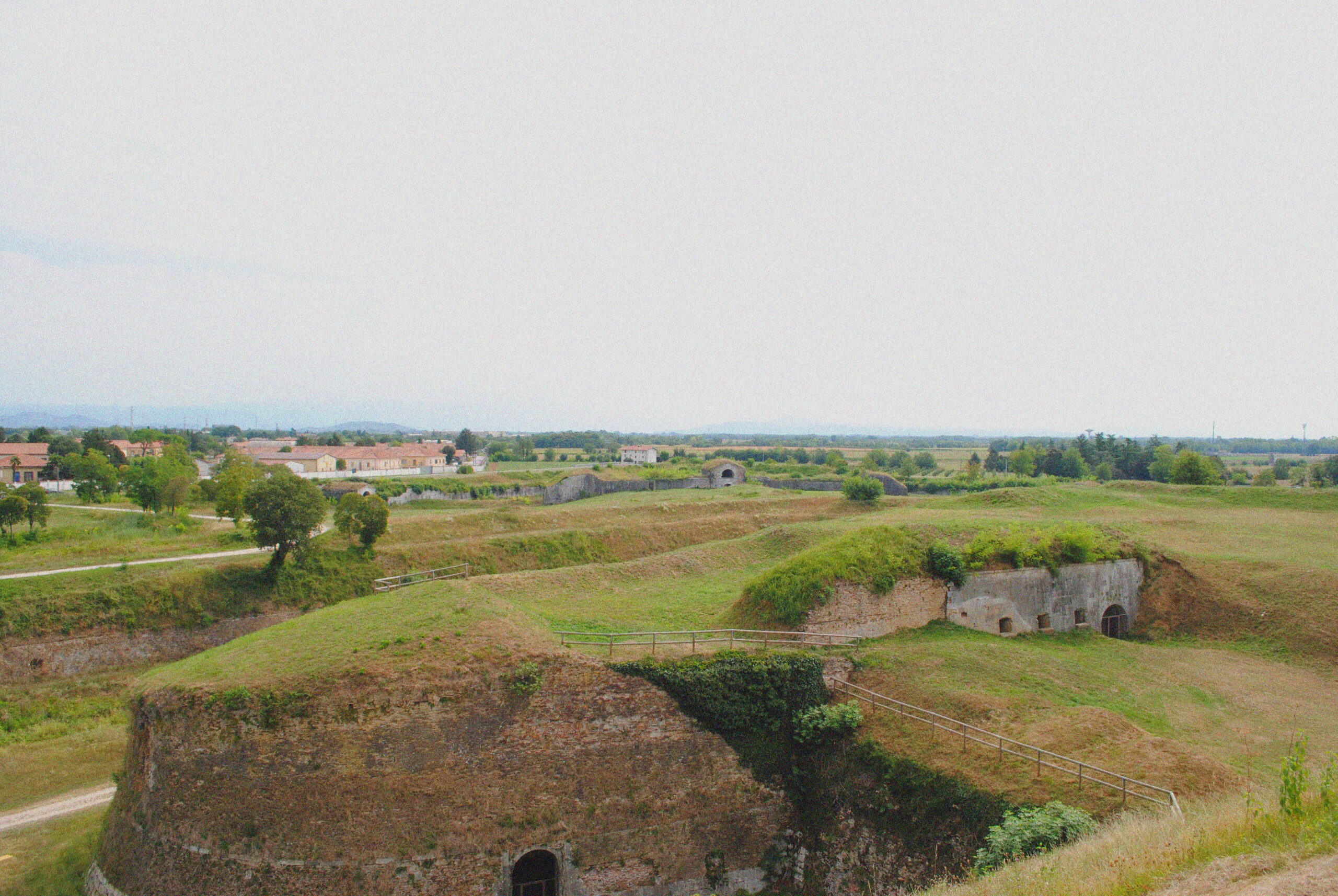On foot between ramparts and bastions
If you arrive in Palmanova by car, I suggest you carefully memorise where you park, because the streets are all very much alike. This is a good reason to reach the star-shaped town by bicycle along the Alpe Adria Cycle Track, by train, which stops outside the walls, or by bus. As you can see, there is no lack of alternatives. Regardless of how you reached Palmanova, I can’t wait to lead you on an unusual zig-zag walk, inside and outside the walls of the star-struck city! The town sprang up from scratch as a fortress, at the behest of the Republic of Venice. Construction began at the end of the 16th century, the objective? To allow the lion of Venice to sleep peacefully under the protection of the imposing military architecture. Let’s start with Piazza Grande (the Great Square), no better name can be given to describe a site. This square was planned as a parade ground and was supposed to hold 20000 people and think that Palmanova today has a population of just over five thousand. The square is in its own right the centre of Palmanova, its beating heart. Here you can find some of the main monuments from the Venetian era, the places where, far from the noise of traffic, you can take a break; on Monday mornings, the square changes its outfit and becomes a place buzzing with people, it is market day. Stalls everywhere, goods of all kinds from fruit to clothing, an unmissable event for not only the local people but also for the many tourists who reach Palmanova just for this special event. The square where you are standing, like a stage, opens the curtain and presents you with its masterpieces: the cathedral, the Palazzo del Provveditore Generale, now the town hall, with the winged lion on the façade, the numerous figures (provveditori veneti) who, with austere bearing, stand motionless and unconcerned on their pedestal, the reproductions of some of the machines used by the Venetians, skilful builders when it came to construction in locations rich of water. The fortress story begins here. A Venetian bulwark against a possible Turkish incursion or perhaps even a defence against the Habsburgs who dominated part of the surrounding territories.
Facing the cathedral, go left, enter Borgo Udine and follow the main street all the way to its end. You will then arrive at one of the three gates that allowed access to the city: Porta Udine. The traffic lights on your right will allow you to pass through the gate without running any risk and will allow you to see this double gate where the wheel used to operate the drawbridge, which unfortunately no longer exists, can still be seen. And here on your right is the Venetian aqueduct and the moat surrounding the fortress. Don’t go straight down the moat, make a small diversion towards the small waterfall which you see on your left. This is where Roggia di Palma flows: consider that it travels over 30 kilometres, crosses the city of Udine, and arrives here to cascade into the city moat. The waterfall is about three metres high. It served as a water conveyor and, after a long period of inactivity, was recently restored. Head down to the right: your gaze will catch some of the architectural and military elements of this site. Bastions, ramparts, bulwarks, and tunnels are all common terms when describing Palmanova. The first time I visited the city, I was barely able to imagine what it had looked like when it was first built and what all these elements were for. For its defence mainly, judging by the range of weapons that had been used at that time. When you reach the second gate, Porta Cividale, heading east, go left. After a few footsteps, you will come across a building: it is the Polveriera (the gunpowder magazine), which was used as a warehouse for gunpowder, and today? It is a venue for temporary exhibitions and events. Between Porta Cividale and the Polveriera, if you wish, there is the possibility of climbing up Baluardo Garzoni. Your gaze will dominate the surrounding countryside and, as it happens, other small buildings further away: the Napoleonic lunettes. Yes, although his was a short stay, Napoleon transformed the fortress by adapting it to the range of his cannons. Retrace your steps back to the gate and now turn right. You are still walking in Parco dei Bastioni (Historical park of the Ramparts), Palmanova’s green lung with over two hundred different species of indigenous plants. Bees are very familiar with this diversity in which they can feast! One of the lunettes houses the hives where the industrious bees produce their “nectar”. Listening to my story, I imagine you have arrived at the third and final gate: Porta Aquileia or Porta Marittima. Back into town along the borough, to your right is the façade of one of the many barracks that have been closed for some time, awaiting their destiny. Turn left onto Contrada Savorgnan, you cannot miss the imposing façade of the Gustavo Modena Theatre, the temple of the culture of Palmanova, which was erected in the first half of the 19th century. We have reached the end of the route, and we can already glimpse Piazza Grande, the façade of the Cathedral and its “dwarf” bell tower, which was built that low to avoid becoming a target for enemy artillery. Standing in the centre is the banner that the people of Palmanova call Mario, and if only it could speak or write its memories, with all the pennants which have been hoisted to its top, it could fill the story with interesting trivia and write the most detailed history book of the city of Palmanova.






